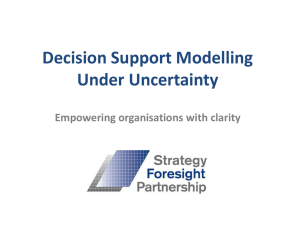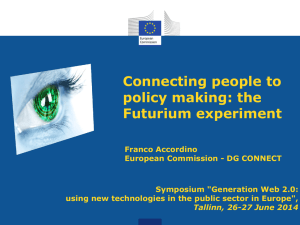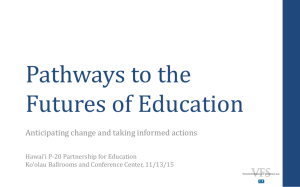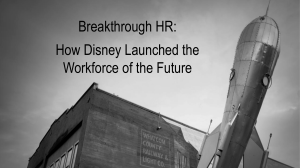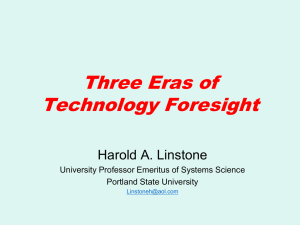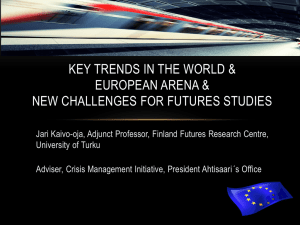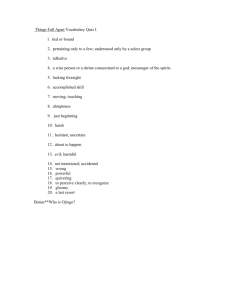The Rise and Fall of Foresight
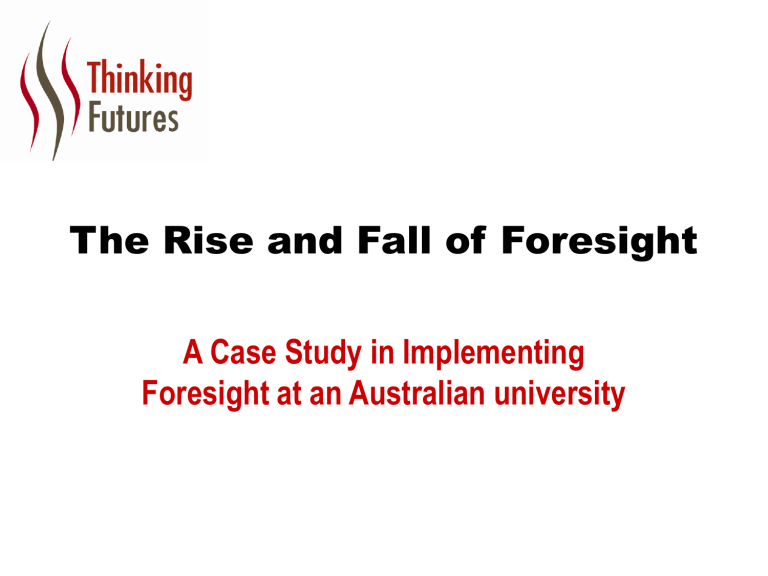
The Rise and Fall of Foresight
A Case Study in Implementing
Foresight at an Australian university
Overview
Case study of an attempt to integrate futures approaches into an existing university planning framework, with the aim of developing an organisational foresight capacity.
Introduced by a foresight champion, but derailed by organisational politics, clash of egos and closed minds.
As always, reflection and hindsight demonstrate a number of lessons to be learned for the future.
Both a case study of how not to introduce foresight to a university, and a personal futures journey.
futures inspired strategy
2002
2003
2004
2005
Timeline
January 1999
June 1999
July-Dec 1999
November 1999
December 1999
March 2000
August 2000
December 2000
January 2001
Feb- Nov 2001
Foresight introduced by Vice-Chancellor
New Foresight Unit established
Desktop research
New planning framework incorporating foresight approved
Foresight Network established
Practice Scenario Planning Workshop
Work begins on development of conceptual framework for foresight
Framework and new scenario workshops ready
Foresight Network disbanded until role could be clarified
Awareness raising seminars
Environmental scanning implemented
Scenario workshops with individual units
University Scenario Project
Implementing University Scenarios Project
Review of Foresight Function and recommendations for future development
New Vice-Chancellor ‘kills foresight’ softly over time
No trace of foresight left in planning framework futures inspired strategy
Beginnings
1999
Internal re-structure
VC says: “we want you to do foresight”
I say (to myself not the VC ): “what the ?!#$ is foresight??”
The journey begins!
Planning Unit renamed to include foresight in the title, with my job
‘Director, Foresight and Planning’.
futures inspired strategy
Beginnings
Desktop research about foresight, and applying it to planning in universities we were breaking new ground.
Should have recognised at this stage how ill prepared I was to do this and stopped!
No experience in the field (thank heavens for the internet), and
No real understanding of organisational politics and egos at work (moved from a faculty to a corporate area).
futures inspired strategy
Aims
In the beginning:
"to facilitate a shift in orientation from paper to people and to provide the context in which the organization, as a whole, can be more reflective about its future…[and] to present staff with an opportunity to be involved, if they wish, in the process of thinking through options for the University's future." futures inspired strategy
Aims
Clarified as:
to inform strategy development and decision making, particularly around future directions, areas of focus and priorities,
to build an organisational foresight capacity to encourage strategic thinking throughout the organisation, and
to provide opportunities for staff to be involved in University planning.
futures inspired strategy
Approach
Needed to get some runs on the board – some early decisions:
Foresight Network – staff champions,
Scenario planning as a methodology, and
Foresight Bulletin – external environmental scanning information.
Foresight as integral element of University Planning Framework.
futures inspired strategy
Approach
University wide ‘practice’ scenario planning exercise in March 2000 – seemed like a good idea at the time!
Foresight Network.
External facilitators.
Senior management involvement at beginning and end.
Horizon 20 Report – four draft scenarios.
Clear that we needed a different approach, based on a stronger conceptual framework.
Some indication of depth of political and personality issues.
Clear that both staff and senior managers need to be involved in the process.
futures inspired strategy
Approach
Conceptual framework for a foresight approach developed over five months in 2000.
By December 2000, we had a new approach:
Business Idea developed,
Foresight Bulletin redesigned as ‘prospect’,
Foresight Snippets,
Introduction to Foresight Seminars, and
Generic Foresight Model.
futures inspired strategy
Approach
Made it clear that foresight doesn’t replace strategic planning; it strengthens it.
In response to a comment from a senior manager that “we didn’t do any strategic planning this year because you were doing foresight”.
Presentations – about foresight and to introduce them to scenario planning – to staff in individual units during 2000 were well received.
futures inspired strategy
Approach
Added modified scenario planning workshops for staff in units – ran these during 2001/2:
Learning Scenarios (4-6 hours),
Exploratory Scenarios (1 day), and
Strategic Implications (1/2 day).
Started to use Causal Layered Analysis in some workshops.
So, foresight implementation was focused around:
‘education’ and ‘profile raising’; and
methodology.
futures inspired strategy
Feedback
Registrar's Department
100% understood foresight better
95% would use scenario planning again
Library
100% understood foresight better
100% would use scenario planning again
Information Technology School
95% understood foresight better
75% would use scenario planning again
Postgraduate Higher Degrees Program
95% understood foresight better
76% would use scenario planning again futures inspired strategy
Feedback
"Thinking beyond the prescribed parameters so that 'wacky' ideas are not regarded as such."
"Sharing our worlds, open discussion on what people are thinking about."
"Made you think outside the box."
"Understanding different perceptions/beliefs people had."
"Helps break out of present mindset."
"Helped to broaden horizons, move out of existing focus, and show that you can think well ahead when required."
"Very insightful and most effective means to critically evaluate and analyse options."
"Scenarios provide a means for a better focused discussion/consideration/planning."
"It showed me that it was not about predicting the future, but about anticipating possible futures, and how to work towards or away from these."
"The opportunity to work in a group and toss around ideas for a world which would not have been my preferred one - this was most stretching." futures inspired strategy
Feedback
"I knew nothing about foresight concepts, now I am interested!"
"Very insightful and well related back to our work in planning and operating our 'core business'."
"...importance of thinking beyond the box and being allowed to do this."
"The process we went through gave me a much clearer understanding of the value it can be to planning for the future."
"Excellent experience."
"The exercise succeeded in broadening my thinking on the one hand, and enabled me to think more clearly and specifically about the (key issue)."
“Good to see staff actively involved.”
“It flushes out all the “hidden” and open issues that most people are unlikely to articulate individually.”
“Stimulating and enjoyable.”
“Interesting and useful.”
“Scenario processes open up the ideas and discussion.” futures inspired strategy
University Scenario Project
Things were looking good, and we were still being tolerated by the senior managers
– but we were effectively ignoring all the signs that told us there was danger ahead!
Had the VC’s ‘authority’ to run a university-wide scenarios project.
March-July 2002 – with Hardin Tibbs and Susanne Haydon (decision that we needed ‘outside’ credibility)
Internal interviews, two workshops, extensive environmental scan.
Two scenarios produced:
Hire-Ed and Life-Learn futures inspired strategy
University Scenarios Outcomes
Scenarios were revised and published in late 2002.
Response: what do we do with these? How do I use these in my everyday work? I can’t see how they relate?
Produced drivers of change as separate publication, which was been used in several internal planning workshops. This scanning publication was ‘familiar’ to managers and of immediate value.
Self-paced Using University Scenarios workbook and supporting material (presentation, notes, video).
Used concept of Cultural Creatives to create a matrix of plausible futures for the university.
Well received, but probably because of the film titles used to describe each future!
futures inspired strategy
University Scenarios Outcomes
Environmental scanning methodology - intensive, focused,
‘real-time’ scanning – a fast track scanning approach.
Attempt to review university’s vision statement in 2004 (to assess current strategy in scenario worlds) was not successful.
New senior leadership.
No participation, ownership or understanding of previous commitment to foresight, or the Scenarios Project.
Did not see value in futures methods.
futures inspired strategy
Environmental Scanning
Foresight Bulletin – prospect – designed around
University’s five strategic themes – the business environment.
Foresight Snippets – information about the broader social environment in which the University exists – delivered by email originally, then in prospect.
Strategic Scanning:
New environmental scanning framework developed.
Strategic Scanning Database.
Scanning Projects.
futures inspired strategy
Environmental Scanning
Internal
Ad hoc scanning ‘hits’ circulated, with some limited analysis; reception varied from ignoring them, being defensive, to engaging in email discussion.
Commissioned scanning reports for units/projects; reception varied from useful to ‘huh?’
External
Developing a package of scanning reports and analysis, including access to online database.
futures inspired strategy
Externally
Conscious that we were doing something different in universities.
Conference presentations.
Papers in journals.
Presentations to government departments.
External scenario planning workshops; word of mouth reputation is kicking in.
Foresight Methodologies Workshop in 2003 and scenario development work for major higher education conference in 2004.
futures inspired strategy
Reaction to Foresight
Initially:
Jokes and laughter about ‘foresight’, disbelief that I’d want such a job title:
quite unprofessional behaviour from some senior staff.
Scepticism, but goodwill (at least I thought so!)
Turns out, lots of active undermining because:
line management issues, and
approach used to implement foresight (even though the intentions were pure) caused the following sorts of reactions:
Don’t tell me how to think about the future.
I don’t need to be ‘taught’ this stuff.
futures inspired strategy
Reaction to Foresight
Then:
Some understanding that we need to think about the future in a more systematic way, but
we don’t have the time to do it….
Staff changes, and continuing changes to the University Planning Framework meant that there not enough time was spent on developing foresight further, and promoting the use of the outcomes of the University Scenario Project.
Entered ‘stealth’ mode for a while.
New leadership arrived at end of 2003 and said “I don’t get foresight”.
futures inspired strategy
Reaction to Foresight
Over 2004, all elements of foresight work removed from planning framework.
University vision statement reviewed to take it out to 2015, but no futures approaches used, despite:
extensive readings
a number of proposals
conversations with a leading futurist
increasingly desperate conversations with me about why foresight was important!
Eventually, realisation that foresight was doomed!
futures inspired strategy
Impact
People recognised ‘foresight’ – but probably most weren’t sure how it could be used in their work.
Those who went through a ‘process’ were generally ‘converted’ and become champions.
Foresight as a process was recognised as valuable – eg plans,
Academic Board Review.
futures inspired strategy
Impact
Performance indicators developed in-house to use to demonstrate impact, based on:
UK Strategic Futures Unit work on best practice.
Battelle Institute: Foresighting Around the World.
Foresight Program Benchmarks developed at Swinburne.
Government foresight good practice.
futures inspired strategy
Why did it fail?
Lack of knowledge of the futures field: best intentions, but an amateur.
Failure to take account of strength and power of organisational politics.
Failure to understand motivations underpinning actions of senior managers.
Closed minds .
futures inspired strategy
Lessons Learned
GENERAL
Language – foresight is not a word that seems to be ‘liked’ in universities.
Introducing foresight as a new concept risks its immediate rejection – needs to be seen as an extension of what is already happening.
There are no ‘future facts’, so convincing managers who are focused on data-driven decision making that they need to spend time on the unknowable is a particular challenge.
futures inspired strategy
Lessons Learned
SUPPORT FROM THE TOP
You need a vocal and strong champion who won’t let foresight be ignored, and who will follow-through on implementation – ie the
CEO is a critical player.
So…ensuring the CEO has a clear understanding of foresight is the first step.
Spend time with the senior executive staff – convince them first: take them through a process to demonstrate value and embed foresight in the university so that when the VC leaves, it is not at risk.
futures inspired strategy
Lessons Learned
ORGANISATIONAL CONTEXT
Tailor the ‘product’ for different organisational contexts.
Political underpinnings of organisations have to be taken into account:
the power of foresight has to compete with the power of people’s egos and personal positionings, ambitions and animosities.
futures inspired strategy
Lessons Learned
PROCESS
Needs a well thought out plan – using the generic foresight model to stage implementation is one way of planning.
Working out how to add value for people in different parts of the organisation – ie some people will want a detailed report, others will want a one page process.
No one is happy to take a day or two off work to do a workshop so expected outcomes need to be clear and agreed.
futures inspired strategy
Lessons Learned
PEOPLE
Need goodwill for people to be prepared to try foresight – at least in a university, where it is not a known or understood approach, so staff chosen to ‘do’ foresight need to have established goodwill and credibility.
People at ‘grass-roots’ often more open to exploring what foresight means than senior management.
futures inspired strategy
Lessons Learned
IMPLEMENTATION
A long term project, with the aim of becoming routine (eg UK Foresight
Project since mid 1990s has resulted – indirectly – in numerous foresight positions in a wide range of organisations being established).
Need a good communication strategy – clarity about terminology and aims. You need to have answers to questions:
Why are we doing this?
What is wrong with what we do now?
How will this help what I am doing today?
Will be difficult – involves shifting mindsets and changing world views. futures inspired strategy
Lessons Learned
KNOWLEDGE
At the beginning, did not understand the necessity of a futures qualification.
Commenced formal study in the futures field in 2004, when it was too late to be of use:
at a time when the new leadership was already ‘killing foresight softly’, so:
the value of, and need for, a foresight capacity became stronger in an environment where it would not be possible to do anymore.
With hindsight, a qualification and knowledge of the field at the
beginning may have contributed to a different outcome.
futures inspired strategy
What would I do differently?
Be upfront about my commitment to using futures approaches in my work.
Ensure that the VC or CEO has AT LEAST an open mind so that the idea is not rejected without exploration.
It’s then my job to demonstrate the value of futures work.
futures inspired strategy
What would I do differently?
Not use the term ‘foresight’ up front and without a context: it confuses and alienates those with closed minds.
Introduce futures approaches as part of the planning framework, and present it as a way to enhance and organisation’s understanding of its future operating environments:
that is, not ‘launch’ foresight as the ‘missing element’, since that risks suggesting that it’s nothing more than another fad,
but rather, demonstrate the value of thinking about the future, as well as the past and the present in strategic processes.
futures inspired strategy
What would I do differently?
Use the generic foresight model as an implementation framework.
Develop Environmental Scanning as first stage.
Use scanning reports included in current planning process to build understanding of value of expanding scanning framework to include futures
‘type’ material.
Gradually introduce key groups to the ‘idea’ and how it might be used.
Then, introduce prospective methods.
Go softly, softly, slowly, slowly.
futures inspired strategy
What would I do differently?
Become better at understanding the motivations of key players, and understanding their worldviews, so I am able to tailor the message for them.
Look for open minds, avoid closed minds (at least at the beginning) and attach less value to formal or positional authority to get things done.
Identify and discuss the many contesting images of the future that exist at the one time in organisations.
futures inspired strategy
Some Challenges
How to create an environment in which organisations are futuresready?
How to move organisations beyond the point where you need a single ‘foresight champion’ to ensure successful implementation, and where foresight is routine and not dependent on a CEO?
How to convey the foresight message so that individuals ‘get it’, and then take foresight into their organisations?
futures inspired strategy
